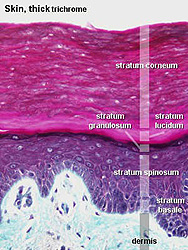Thick skin is found on
fingertips, palms and soles of feet. It is specialized for
protection during friction and contains sensory receptors responsive
to pressure, the Pacinian corpuscles. Thin skin covers most of the
body and is similar in many respects to thick skin. For example,
thin skin contains hair follicles but does not have Pacinian
corpuscles to respond to pressure and friction. .
Examine a section of thick skin and identify epidermis and
dermis.
- In the dermis, note the difference
between the papillary and reticular layers.
- Note too how downward epidermal folds or
ridges interdigitate with upward projecting dermal papillae.
- In the epidermis, identify
characteristic cells, keratinocytes, (as seen in Fig. 18-2)
representing the
- Stratum basale,
- Stratum spinosum,
- Stratum granulosum, and
- Stratum corneum
- Click image to right for
expanded view.
- The strata grade into one another
and cells gradually move outward from the basal layer to the
cornified layer.
What do the small “spines” on
keratinocytes of the spinous layer represent?
What is contained in the granules of the keratinocytes of the
granular layer?
Since the cells there are dead, why is the cornified layer so
critically important?
How does melanin get from the melanocytes into the keratinocytes?
List several functions of the dermis and hypodermis.
The skin as a route of
medication delivery. |